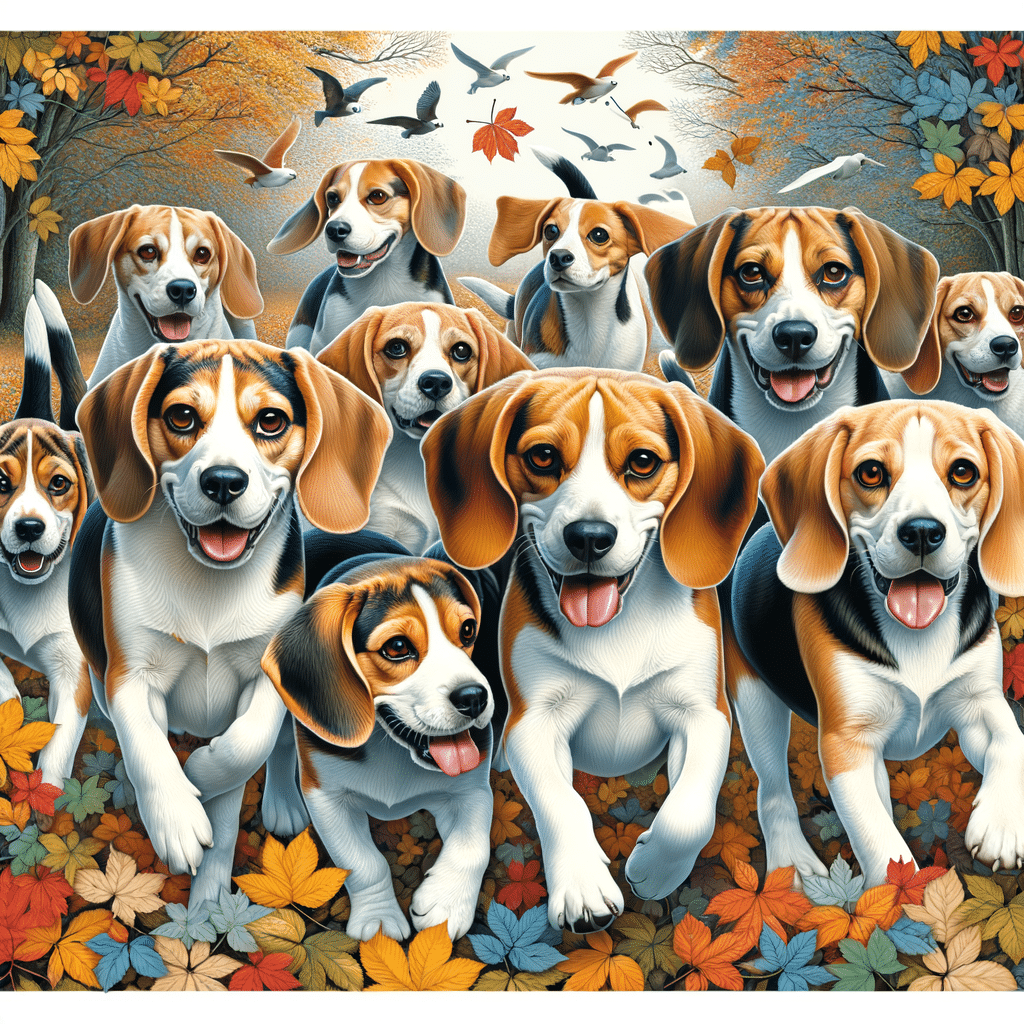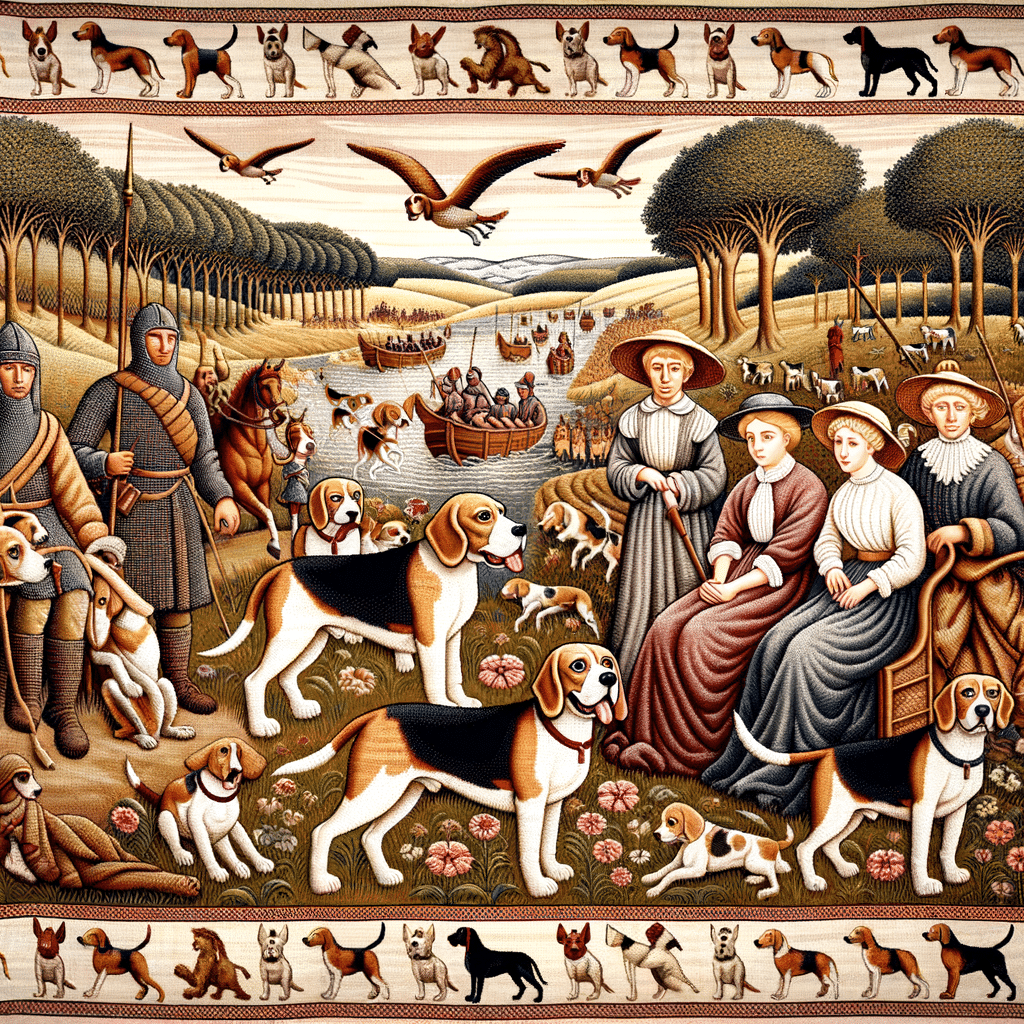Miniature beagles, commonly called pocket beagles, are a smaller version of the standard beagle, a breed well-known for its keen sense of smell and tracking ability. Though not officially recognized by all breed organizations, these diminutive hounds typically stand between 7 and 13 inches tall at the shoulders and seldom weigh more than 15 pounds. Their traits mirror the standard beagle, presenting a compact, sturdy structure with a smooth coat in various color patterns, including the classic tricolor.
In This Article
The appeal of the miniature beagle goes beyond their convenient size; these dogs possess a charismatic temperament that captures the hearts of their owners. Their expressive faces, with large, beguiling eyes and long, drooping ears, add to their charming personality.
Potential owners need to consider that despite their reduced stature, these pocket beagles have care requirements and behavioral traits similar to their larger standard beagle counterparts, including a penchant for following scents and a lively spirit that benefits from active homes.
Highlights
- Miniature beagles are up to 13 inches tall and weigh 15 to 18 pounds.
- They share physical traits and temperaments with standard beagles.
- Pocket beagles require active homes and proper care akin to their larger counterparts.
Origins and History
The miniature beagle carries a history dating back to medieval times, with its origins steeped in the hunting tradition of England.
Historical Development
During medieval England, the term “beagle” was used generically for small hounds, with records dating back to the reign of Edward II and Henry VII. Queen Elizabeth I favored a breed known as a pocket beagle, which was small enough to fit in a pocket or on a glove. These breeds are said to be around 8 to 9 inches tall and serve as the early forerunners to the modern miniature beagle. Through selective breeding over time, the original genetic line of these tiny hounds became extinct by the 19th century.
Recognizing the Breed
Regarding formal recognition, the miniature beagle lacks standard beagles’ official breed status. However, these dogs are characterized by their size, typically bred smaller than the standard beagle. Historically, such scent hounds were not identified by a specific breed but rather by their purpose and size, which was suited for the convenience of hunters during outings.
Physical Characteristics
The miniature beagle, a smaller variant of the original breed, manifests distinct physical attributes.
Size and Proportion
Miniature beagles are smaller versions of the standard beagle. They usually stand between 7 and 13 inches tall and weigh between 7 and 18 pounds. This breed is crafted to fit the traditional beagle appearance but in a diminished form, retaining the beagle’s proportions in a more portable package.
Color Variations
The coat of a miniature beagle comes in customary colors, including combinations of black, red, white, tan, lemon, blue, and liver. These colors can appear in various patterns and markings. Still, they are always vibrant, contributing to the breed’s eye-catching appeal.
Common Physical Features
These small pups have distinct physical features that align with the beagle’s breed standards, albeit in a smaller frame.
Key characteristics include:
- Eyes: Typically, they have large, hazel eyes, displaying an expression of curiosity.
- Coat: Their short, dense coat is weather-resistant, aiding in upkeep and suitability for various climates.
- Ears: Long, floppy ears are a hallmark trait, extending towards the nose when drawn out.
- Build: Despite their smaller size, they have a sturdy and well-muscled build, courtesy of their hunting dog ancestry.
Health and Care
Caring for miniature beagles, commonly referred to as pocket beagles, involves:
- Addressing their specific health concerns.
- Ensuring proper nutrition.
- Maintaining a regular grooming routine.
A proactive approach is vital for their well-being as their smaller size may predispose them to certain health issues.
Addressing Health Concerns
Pocket beagles may experience health problems common to small breeds, such as dwarfism, heart issues, and obesity. Regular veterinary check-ups are important for early detection and treatment of such conditions.
Owners should also be aware of symptoms indicating potential health issues, including lethargy, excessive weight gain or loss, and unusual changes in behavior or appetite.
Nutrition and Diet
The diet of a pocket beagle should consist of high-quality dog food tailored to smaller dogs.
An ideal meal plan would include:
- Proper balance of protein, carbohydrates, fats, and fibers
- Limit treats to avoid obesity
- Careful monitoring of portion sizes to maintain healthy weight
It’s recommended to split meals into two servings per day and consult a veterinarian to determine the most suitable dog food for the breed’s energy needs and health profile.
Grooming and Maintenance
Miniature beagles have moderate grooming needs. They require regular brushing to reduce shedding and maintain coat health.
Their grooming routine should include:
- Brushing: At least twice a week to remove loose fur and distribute skin oils
- Ear cleaning: Weekly to prevent infections due to their long, floppy ears
- Nail trimming: Monthly or as needed for safety and comfort
Practical grooming keeps the pocket beagle in good shape and enhances their overall quality of life. Additionally, grooming sessions should be seen as opportunities to check for skin issues or parasites.
Regular exercise is also an integral part of caring for a pocket beagle. Daily activity supports good health, prevents obesity, and promotes mental stimulation.
Temperament and Behavior
Miniature beagles are known for their friendly and curious nature, which makes them delightful companions. They exhibit a blend of enthusiasm and affection balanced with moderate independence.
Personality Traits
The miniature beagle’s temperament is one of gentleness and affectionate disposition. They are fun-loving dogs that thrive on companionship and interaction with their human families. While generally not an aggressive breed, Miniature beagles retain their larger ancestors’ hunting instincts, which can sometimes manifest as a strong following of scent trails or an eagerness to explore their environment.
- Vocal Tendencies: They can be vocal, with a penchant for barking and even “singing,” especially if they catch an interesting scent or become bored.
- Energy Level: High; they require regular exercise to manage their energy.
- Intelligence: Intelligent but can display a stubborn streak, which may be a consideration during training sessions.
Training and Socialization
Though miniature beagles are clever, training them should be approached with patience due to their occasionally stubborn behavior. Consistency and positive reinforcement are key training strategies. Begin this process early to mold their behavior positively.
- Boredom: Without adequate mental and physical stimulation, they can become restless or bored, which can lead to destructive behaviors.
- Socialization: It is crucial to socialize them early to foster a well-rounded temperament, as they are naturally inclined to be friendly with humans and other dogs.
Frequently Asked Questions
In this section, readers will find concise answers to common inquiries about the miniature variant of the beagle.
What are the typical characteristics of a full-grown pocket beagle?
A full-grown pocket beagle typically exhibits characteristics similar to standard beagles‚ friendly, curious, and energetic. However, they come in a smaller package, usually standing 7-12 inches tall.
How do pocket beagles compare in size to standard beagles?
Standard beagles can stand up to 15 inches at the shoulder. Pocket beagles generally measure between 7 and 12 inches in height.
What is the average lifespan of a teacup beagle?
The average lifespan of a teacup or mini beagle can vary. Still, they usually enjoy a life expectancy similar to standard beagles, about 10-15 years.
How prevalent are pocket beagles today, and are they considered a rare breed?
Pocket beagles are not as common as their standard counterparts, so they may be considered rare. But they continue to appeal to those seeking a smaller dog with beagle traits.






